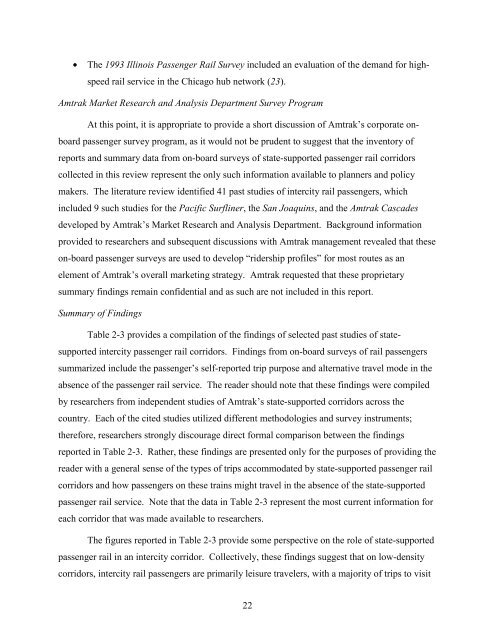Measuring the Benefits of Intercity Passenger Rail: A Study
Measuring the Benefits of Intercity Passenger Rail: A Study
Measuring the Benefits of Intercity Passenger Rail: A Study
Create successful ePaper yourself
Turn your PDF publications into a flip-book with our unique Google optimized e-Paper software.
• The 1993 Illinois <strong>Passenger</strong> <strong>Rail</strong> Survey included an evaluation <strong>of</strong> <strong>the</strong> demand for highspeed<br />
rail service in <strong>the</strong> Chicago hub network (23).<br />
Amtrak Market Research and Analysis Department Survey Program<br />
At this point, it is appropriate to provide a short discussion <strong>of</strong> Amtrak’s corporate onboard<br />
passenger survey program, as it would not be prudent to suggest that <strong>the</strong> inventory <strong>of</strong><br />
reports and summary data from on-board surveys <strong>of</strong> state-supported passenger rail corridors<br />
collected in this review represent <strong>the</strong> only such information available to planners and policy<br />
makers. The literature review identified 41 past studies <strong>of</strong> intercity rail passengers, which<br />
included 9 such studies for <strong>the</strong> Pacific Surfliner, <strong>the</strong> San Joaquins, and <strong>the</strong> Amtrak Cascades<br />
developed by Amtrak’s Market Research and Analysis Department. Background information<br />
provided to researchers and subsequent discussions with Amtrak management revealed that <strong>the</strong>se<br />
on-board passenger surveys are used to develop “ridership pr<strong>of</strong>iles” for most routes as an<br />
element <strong>of</strong> Amtrak’s overall marketing strategy. Amtrak requested that <strong>the</strong>se proprietary<br />
summary findings remain confidential and as such are not included in this report.<br />
Summary <strong>of</strong> Findings<br />
Table 2-3 provides a compilation <strong>of</strong> <strong>the</strong> findings <strong>of</strong> selected past studies <strong>of</strong> state-<br />
supported intercity passenger rail corridors. Findings from on-board surveys <strong>of</strong> rail passengers<br />
summarized include <strong>the</strong> passenger’s self-reported trip purpose and alternative travel mode in <strong>the</strong><br />
absence <strong>of</strong> <strong>the</strong> passenger rail service. The reader should note that <strong>the</strong>se findings were compiled<br />
by researchers from independent studies <strong>of</strong> Amtrak’s state-supported corridors across <strong>the</strong><br />
country. Each <strong>of</strong> <strong>the</strong> cited studies utilized different methodologies and survey instruments;<br />
<strong>the</strong>refore, researchers strongly discourage direct formal comparison between <strong>the</strong> findings<br />
reported in Table 2-3. Ra<strong>the</strong>r, <strong>the</strong>se findings are presented only for <strong>the</strong> purposes <strong>of</strong> providing <strong>the</strong><br />
reader with a general sense <strong>of</strong> <strong>the</strong> types <strong>of</strong> trips accommodated by state-supported passenger rail<br />
corridors and how passengers on <strong>the</strong>se trains might travel in <strong>the</strong> absence <strong>of</strong> <strong>the</strong> state-supported<br />
passenger rail service. Note that <strong>the</strong> data in Table 2-3 represent <strong>the</strong> most current information for<br />
each corridor that was made available to researchers.<br />
The figures reported in Table 2-3 provide some perspective on <strong>the</strong> role <strong>of</strong> state-supported<br />
passenger rail in an intercity corridor. Collectively, <strong>the</strong>se findings suggest that on low-density<br />
corridors, intercity rail passengers are primarily leisure travelers, with a majority <strong>of</strong> trips to visit<br />
22
















